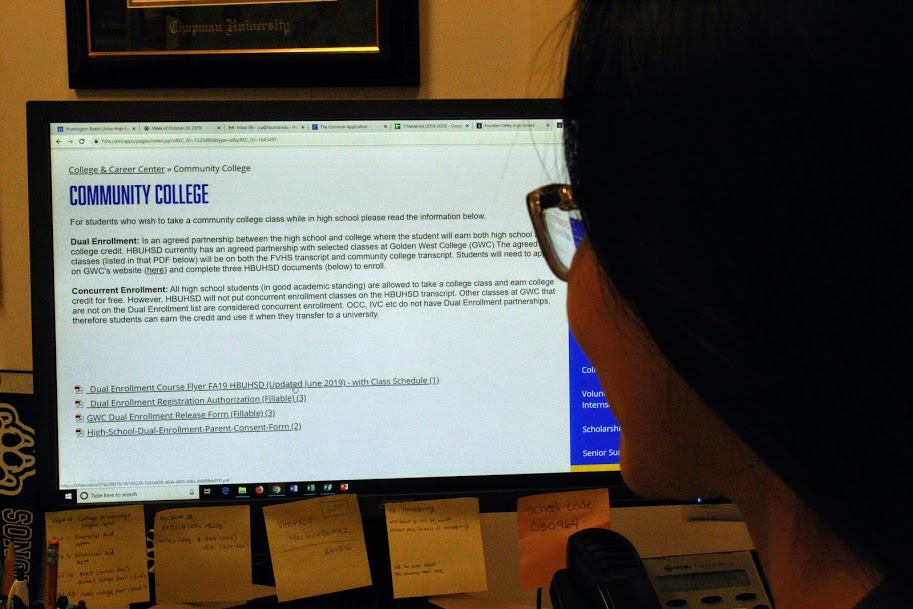
By Karen Phan, Opinion Editor
FVHS offers three programs that grant students college credit: concurrent enrollment, dual enrollment and Advanced Placement (AP).
Concurrent enrollment
Concurrent enrollment is when high school students take community college classes to earn college credit. The classes are taken at a college campus and/or online as hybrid or online classes.
“[Concurrent] classes are college-level classes,” College and Career Specialist Irene Yu said. “They will go on your transcript so you want to do well.”
Community college classes are free for high school students, but students are responsible for buying course materials such as textbooks and paying college service charges or health fees.
“As long as the student is enrolled in high school while he/she is taking the community college class, he/she will not have to pay for the community college class,” Yu said.
There are limitations to transferring credits earned at a community college to a university. One of the two restrictions that are likely to affect concurrent enrollment students are college credit expiration. If a student earned college credits in their freshman year of high school, then those credits might have expired by the time they’re a high school senior. The second limitation is non-transferable credits due to different curricula at different colleges.
“The classes might transfer over to a four-year [university], but that depends on what classes you take and where you want to transfer to,” Yu said.
To be successful in transferring credits, students can research the credit transfer policy for the university they are interested in and speak to an adviser at that university and Yu for guidance, especially if they are looking to transfer credits out of state.
Students can also use assist.org, the official California course articulation and student-transfer information system, to find out how credits earned at one California college or university transfer to another institution.
“Either way, if you took an introductory class to Health Careers and Medical Terminology, it’ll at least give you a good foundation regardless [of] if the class counts for a four-year,” Yu said.
Some community college classes are also career-based or are part of a sequence of classes to earn a certificate for a particular program. In this way, concurrent enrollment is similar to the regional occupational programs, commonly known as ROP/CTE, that provide students with career preparation and technical education. Those who plan to go to community college after graduating may appreciate that concurrent enrollment gives them a head start in earning a certificate.
“Students who are interested in learning about a subject that isn’t offered on our campus should take [community college] classes,” Yu said. “If you wanted to take intro to ethics or philosophy, that would be a great eye-opener to see if that is something you want to learn more about.”
In order to take college classes, FVHS students must enroll at their desired community college and fill out a special part-time high school release form found on the community college website to get permission from FVHS to take the classes. The paperwork must then be approved by the college. Students can talk to Yu for guidance on the enrollment process.
College classes fill up quickly and high school students are not given priority nor are they allowed to be on the waitlist for a course, so students should sign up as soon as the registration window for the term opens. Coastline Community College, Golden West College (GWC), Irvine Valley College and Orange Coast College are local community colleges that FVHS students can look into.
Dual Enrollment
Whereas concurrent enrollment only grants students college credit, dual enrollment grants credit for both high school and college when students take community college classes.
“Dual enrollment is an agreed partnership between our district and the community college so that you can earn credit for both high school and college,” Yu said.
The HBUHSD has an agreed partnership with GWC, and there are currently seven classes offered at several campuses in the HBUHSD such as American Sign Language and Mindset of Business Success. FVHS is hosting four courses for the 2019 fall semester that can be found in this PDF.
Dual enrollment classes are taken at the high school campus after school, and some are hybrid classes that have online instruction at home. School counselor Marilyn Wong and Yu can help FVHS students enroll at GWC and register for dual enrollment courses.
“[Students] have to be aware of their own schedule,” Yu said. “You may not be able to juggle the coursework of your sixth period day plus the college class.”
AP
High school students commonly earn college credit through the Advanced Placement (AP) program. FVHS offers 25 AP courses for students to take in order to prepare for AP exams in May. If they get a 3, 4 or 5 on their AP exams, then they may be able to get subject credit to fulfill a college class or elective credit. AP classes are not required to take AP exams.
The AP credit policy varies among colleges and universities. For example, some universities only grant subject credit for 4’s and 5’s while others don’t grant credit at all. Again, it’s important that students research the AP credit policy at the colleges or universities they’d like to attend.
“There’s a lot of overlap between all of these programs,” Yu said. “The main difference is that one program offers classes that the other might not offer.”
For more information about concurrent and dual enrollment, schedule an appointment to visit Yu in the College and Career Center, and for more information about AP, visit Assistant Principal of Curriculum Josh Lamar in the Administration building.





